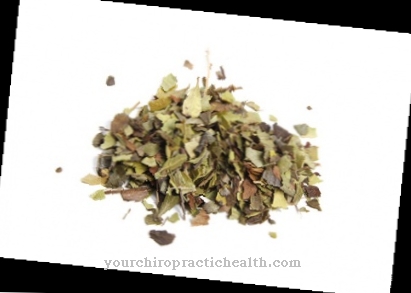Even the Greek doctor Hippocrates used it Poison lettuce as a remedy. The Roman Emperor Augustus is said to have recovered from a serious illness thanks to the medicinal plant. The poison lettuce was used in this country as a natural remedy up to a hundred years ago.
Occurrence and cultivation of the poison lettuce
Of the Poison lettuce (Lactuca virosa) will because of its unpleasant smell too Smelly salad called. Further names of the sunflower family (Asteraceae) belonging plants Wild lettuce and Opium lettuce.The poison lettuce is an annual or biennial herbaceous plant that reaches a height of 0.60 to 1.20 meters and has a spindle-shaped root. Its light reddish overflowing stem contains a milky juice. The plant has blue-green, egg-shaped leaves that are serrated on the edge and have spikes in the middle on the underside of the leaf. It grows from a basal leaf rosette.
12 to 16 light yellow ray-florets stand together at the end in a pyramidal panicle. After the flowering period (July to September), the dark brown fruits of the poison lettuce scatter their seeds (umbrella fliers). The ancient medicinal plant originally comes from the Mediterranean area and was introduced throughout Europe by the Romans. As recently as the middle of the 19th century, there were huge areas of cultivation with poison lettuce on the Moselle. It was even exported to North America.
Today the herb grows wild all over Europe, West Asia and North Africa. The poison lettuce prefers sunny, warm locations on dry, nutrient-rich, weakly alkaline soil and stony surfaces. Its leaves have a bitter-sharp taste. If you want to use it as a medicinal plant, you should collect and dry its leaves during flowering. The milky sap is tapped for several months before flowering and dried in the sun.
Effect & application
The poison lettuce contains bitter substances, organic acids, rubber, inulin, flavonoids, one to two percent carbohydrates, 0.25 percent fat, one to two percent protein, a lot of fiber, dihydrolactucin, the glycoside lactuside A, lactucin, jacquinelin, lactucopicrin, Sesquiterpene lactones, alpha-lactucerol, beta-lactucerol and in the milky juice of the stalk beta-amyrin, gennanicol and taraxasterol.
The leaves are boiled in dried and crushed form into tea and extract and used orally. The milky juice is dried and also taken. In addition, the freshly collected leaves can still be crushed and used for pap poultices (external use). Poison lettuce has a psychoactive effect: it has a sedative effect and, in higher doses, even narcotic.
It soothes, relieves pain and has a sleep-inducing effect. It also has antitussive, astringent, diuretic and antispasmodic properties. The milky juice is obtained like opium and consumed in a drink or enjoyed straight. With it, however, the patient should dose with particular care, as it has a stronger effect than the entire poison lettuce plant (no more than 0.1 to 0.5 grams per day).
If you want to make yourself a tea to treat your nervous restlessness or to drain your water, take one or two teaspoons of the dried and chopped herb and pour 250 milliliters of boiling water on it. After 15 minutes, he strains the tea and drinks three cups of it throughout the day. The dried leaves can also be chewed or smoked in a pipe. They have a pleasant taste and do not cause a sore throat.
To make the extract, 10 to 20 grams of dried herb are simmered with one liter of water for one to two hours over low heat. The thick extract remaining in the pot after the water has evaporated can be diluted with lemon juice. If the patient wants to use poison lettuce to relieve his symptoms, he should use very low doses:
Only one to two grams of herb daily is absolutely harmless. At significantly higher doses, poisoning occurs with symptoms such as sweating, headaches, vomiting, dizziness, stomach pressure, drowsiness, increased need for sleep, unsteady gait, itchy skin, palpitations and shortness of breath. Severe overdose can result in death from heart failure.
Importance for health, treatment & prevention
The poison lettuce was used as a highly effective sleep and sedative until 100 years ago. Five grams of herb are enough to use it like this. Lactoside A is primarily responsible for the properties that cure hyperactivity, nervous restlessness and sleep disorders. It has an opium-like effect without having its addictive potential at the same time. Milky sap was used as a mild pain reliever in the 18th and 19th centuries.
Lactucin, dihydrolactucin, and lactucopicrin actually showed pain relieving properties. The milky sap was also used as an anesthetic in operations before the invention of chloroform. Poison lettuce is also effective as a cough suppressant. Natural medicine used it to treat chronic mucosal catarrh, chronic bronchitis, whooping cough, habitual coughing, dry cough and even bronchial asthma.
It was used because of its draining effects for gout and rheumatism and because of its antispasmodic properties for intestinal colic and colic-like menstrual pain. He also helped with disorders of the female menstrual cycle (dysmenorrhea). Mash poultices with the freshly crushed leaves of the medicinal plant were applied to areas of skin affected by couperose and in chronic eye infections with poor eyesight.
Today the poison lettuce is only prescribed as a homeopathic remedy because of its unsafe dosage. Lactuca virosa is obtained from the fresh whole plant collected at the time of flowering and prescribed as an original tincture in D3 and D4 and Teep (one to three tablets daily). Therapeutic areas of application are insomnia and dry cough.




























